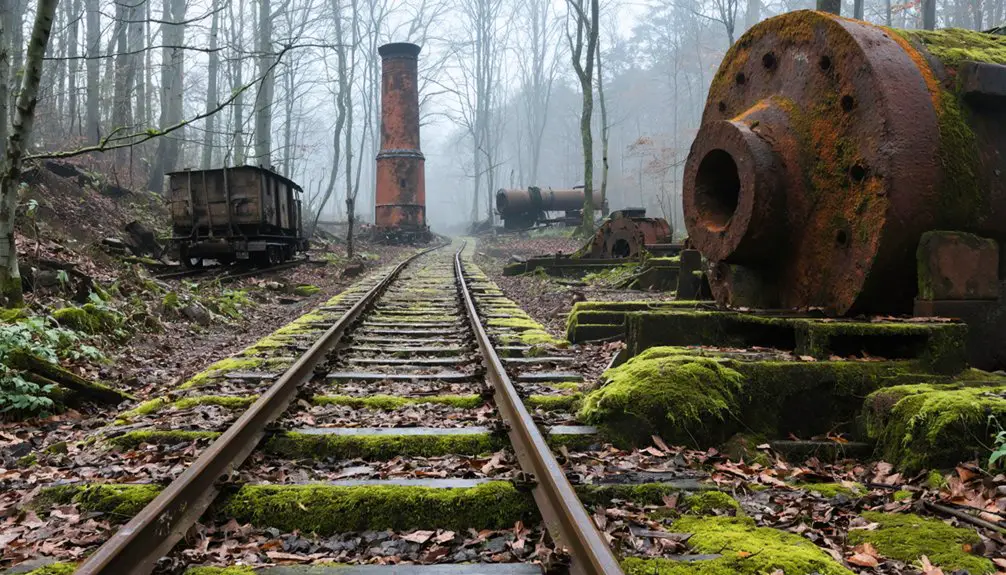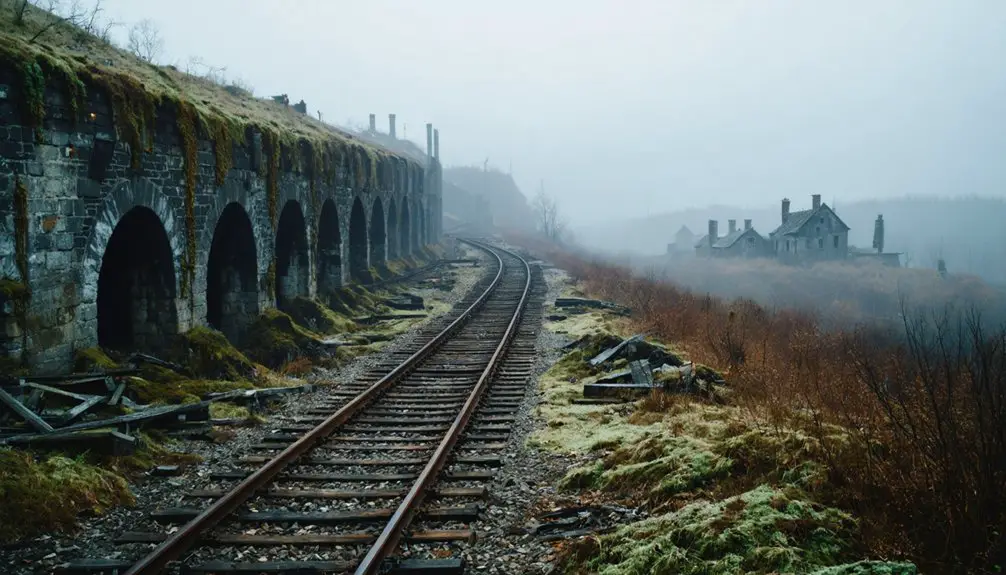You’ll find Loop nestled in Pennsylvania’s coal country, where it emerged as a bustling mining town in the 1800s. The community thrived with company-built housing, stores, churches, and schools, all controlled by mining operations. In 1962, an underground coal fire devastated the area, forcing residents to abandon their homes. Today, you can explore Loop’s remnants along the 46-mile Ghost Town Trail, where markers and exhibits reveal the fascinating story of this lost coal mining community.
Key Takeaways
- Loop was a Pennsylvania mining town that flourished during the coal boom but declined when mining operations became unprofitable in the 1920s-1930s.
- The town featured company-managed housing, churches, schools, and stores, with daily life heavily controlled by mining companies through scrip currency.
- An underground coal fire ignited in 1962 created a hazardous wasteland, forcing evacuations and causing environmental devastation.
- The Ghost Town Trail, established in 1991, preserves Loop’s history through interpretive markers and remnants of abandoned mining infrastructure.
- Loop’s legacy represents Pennsylvania’s coal mining heritage, with visible remains including mine gob piles and coal-washing plants from early 20th-century operations.
Origins and Early Life in Loop Mining Town
While many Pennsylvania mining towns sprouted up during the industrial age, Loop’s origins trace back to 1808 when the Loop brothers, Henry and likely John, first settled in McKean County.
The Loop brothers pioneered McKean County’s settlement in 1808, long before Pennsylvania’s industrial mining boom transformed the region.
You’ll find their pioneer lifestyle reflected in early tax records from 1843-44, where John and Norry Loop appear as resident taxpayers, establishing a lasting family legacy in the region.
The Loop family’s influence grew substantially by the 1880s when they dove into oil drilling ventures.
They’d become major players in the booming Bradford oil field, with family members like Lewis and Miles Loop each controlling 15-16 wells.
Their entrepreneurial spirit transformed the settlement as they partnered with companies like Downing and Company and Erie City Oil Company, developing over 40 wells across Indian Creek, Kansas Branch, and Rixford Farms. Like other mining towns that would later become ghost towns, Loop’s eventual decline was part of a larger pattern in Pennsylvania’s industrial history.
Among these early settlers, Ezra Benjamin Loop established himself as a prominent businessman by becoming a successful inn holder in the region.
Daily Living and Community Infrastructure
Looking at Loop’s community layout, you’d have found basic amenities similar to those in Centralia, with company-managed housing arranged in rows to support the mining families.
You’d notice how the town’s services, while modest compared to larger mining communities, included essential infrastructure like drainage systems to keep the mines operational.
The company’s tight control over housing and facilities meant that when mining operations declined, the entire community infrastructure quickly deteriorated, leading to the town’s abandonment. Like the nearby Landing Tavern that served travelers and boatmen, Loop’s facilities couldn’t survive once economic activity ceased. Similar to Centralia’s peak around 1890, the town once had a thriving population of workers and their families living in close-knit neighborhoods.
Community Facilities and Services
The community facilities in Loop and nearby ghost towns reflected the typical infrastructure of Pennsylvania coal company settlements.
You’d find essential community hubs like churches, schools, and company stores serving as central gathering spots. In Wehrum, the largest nearby town, residents had access to a hotel, jail, bank, post office, and two churches.
Similarly, Claghorn featured an impressive 22-room hotel and a multipurpose school-theater building. The economic impact study from 1996 showed how these community facilities continued to draw visitors long after the towns were abandoned.
These facilities provided basic social services, though they were largely controlled by mining companies. The company stores dominated commerce, where you’d use company scrip instead of cash for purchases. The area was originally Delano’s domain, developed by President Franklin Roosevelt’s uncle Warren Delano.
Schools often doubled as entertainment venues, while churches supported social welfare beyond religious services. Water came from local sources, and the Pennsylvania Railroad‘s Ebensburg & Blacklick line connected these communities to the outside world.
Housing and Company Management
Beyond the community facilities, housing in Loop exemplified the tight control mining companies held over workers’ lives. The close-knit wooden frame structures, typical of company housing, kept miners tethered to their workplace through a system of wage-deducted rent and restricted maintenance options.
You’d find these houses arranged in uniform patterns, often segregated by ethnicity or job position. Daily life revolved around company-provided infrastructure, with basic utilities and coal-burning stoves connecting every aspect of a miner’s lifestyle to their employer. Similar to the small town of Alvira, these communities were subject to the whims of external forces that could dramatically alter their fate. Like many settlements in Westmoreland County, Loop’s infrastructure gradually crumbled as mining operations dwindled.
The mining company’s grip extended beyond physical shelter – they’d use housing assignments and the threat of eviction to maintain workforce discipline. As mining operations declined, company management withdrew services, leaving Loop’s homes to deteriorate and eventually transforming the once-bustling community into a ghost town.
The Economic Rise and Fall
You’ll find Loop’s economic trajectory mirrored many Pennsylvania coal towns, beginning with rapid growth as mining companies like Lackawanna Iron and Coal established operations and built worker housing in the early 1900s.
Local prosperity peaked during the coal boom years when company stores, hotels, and other businesses served the growing population of miners and their families. Similar to Centralia which reached a peak population of nearly 2,800 residents, Loop experienced significant growth during its heyday. The area’s rich anthracite deposits fueled decades of industrial expansion and community development.
The town’s fortunes plummeted in the 1920s and 1930s as mining operations became unprofitable, leading to mass closure of both mines and the businesses that depended on them.
Mining Jobs and Growth
During the mid-1800s, Loop experienced dramatic economic growth as bituminous coal mining transformed this western Pennsylvania town into a thriving industrial hub.
You’d have seen waves of immigrant workforce, particularly from Southern and Eastern Europe, pouring into Loop as economic demand for coal skyrocketed. Pittsburgh alone devoured over 400 tons daily by 1830, driving an unprecedented mining boom.
The expansion of railroads and river transportation made Loop’s coal highly accessible, cementing its role in powering America’s industrial revolution.
Mining companies multiplied, offering abundant jobs through the late 19th and early 20th centuries. While underground room-and-pillar mining dominated initially, operations gradually shifted toward surface mining, though this evolution brought both opportunities and challenges to Loop’s growing economy.
Company Town Development
As Loop’s mining operations expanded in the late 1800s, the town transformed into a classic “industrial satellite” under tight corporate control.
You’d find every aspect of daily life managed by the company – from the homes you could rent to the stores where you’d shop. The company town dynamics followed a familiar pattern: segregated housing based on worker status, with managers in larger homes while laborers crowded into basic row houses.
Under industrial paternalism, you’d have access to company-built churches, recreation facilities, and schools – but at a price.
The company controlled local governance, banned independent newspapers, and restricted public speech against their interests. You couldn’t even frequent taverns without company approval.
This strict oversight created mounting tensions between workers seeking autonomy and corporate leaders determined to maintain their authority.
Local Business Closure Impact
The closure of Loop’s central coal mining operations triggered a devastating economic chain reaction throughout the town’s business community.
You’d have seen the impact ripple through every sector as local shops, hotels, and service providers lost their customer base. Despite attempts at business revitalization strategies, the town’s heavy dependence on coal mining proved insurmountable when market prices plummeted and the Great Depression hit.
Community resilience initiatives struggled as banks closed, credit dried up, and the population dwindled. The loss of rail service in the 1960s dealt another blow, cutting off essential transportation links.
While some held out hope through bootleg mining operations, the economic foundation had crumbled. Today, only a small workforce of about 40 remains in nearby mining operations, a shadow of Loop’s former prosperity.
Environmental Impact and Remnants Today

Since igniting in 1962, an unrelenting underground coal fire has devastated Loop’s environment and transformed it into a hazardous wasteland.
An unstoppable coal fire rages beneath Loop, transforming a once-thriving community into desolate, toxic land since 1962.
You’ll find the fire spreading 3-7 meters yearly beneath the surface, releasing toxic emissions including carbon monoxide, carbon dioxide, and arsenic compounds through ground fissures. This environmental degradation has permanently altered soil chemistry and destabilized the ground, creating dangerous sinkholes and thermal vents.
You can now see the fire’s destructive legacy everywhere – abandoned buildings, closed roads, and a scarred landscape unsuitable for development or agriculture.
Route 61’s closed sections and scattered smoke vents serve as stark reminders of nature’s untamed power. While forest has reclaimed some areas, the underground inferno continues its relentless burn, projected to last hundreds of years.
The Ghost Town Trail Experience
Established in 1991, Ghost Town Trail offers visitors a compelling 46-mile journey through Pennsylvania’s coal mining heritage between Black Lick and Ebensburg.
You’ll discover remnants of abandoned mining towns like Wehrum, Bracken, and Claghorn as you traverse this former railroad corridor, now a National Recreation Trail.
During your trail exploration, you’ll find interpretive historical markers explaining the stories of these lost communities, including the historic Eliza Furnace.
The trail’s well-maintained surface welcomes you year-round for cycling, hiking, and cross-country skiing.
You can start your adventure at Saylor Park near Black Lick, following Blacklick Creek through scenic terrain.
While most ghost town sites remain on private property, the trail’s extensive guides and interactive flipbooks help you understand the region’s rich industrial past.
Legacy and Historical Significance

Located along Pennsylvania’s historic Ghost Town Trail, Loop stands as a poignant reminder of the region’s coal mining heritage and industrial revolution.
You’ll find its legacy deeply woven into the cultural memory of Pennsylvania’s industrial heritage, reflecting a time when company towns shaped the social and economic landscape of Appalachia.
- Loop’s development alongside the Pennsylvania Railroad’s Ebensburg & Blacklick line showcases the essential connection between transportation infrastructure and industrial growth.
- The town’s remnants, including mine gob piles and coal-washing plants, tell the story of early 20th-century mining technology and labor.
- As part of the Ghost Town Trail corridor, Loop’s history is preserved through historical markers and interpretive exhibits, documenting the rise and fall of Pennsylvania’s coal mining communities.
Frequently Asked Questions
Were There Any Notable Crimes or Lawlessness in Loop During Its Peak?
While you might imagine Wild West-style disorder, Loop’s crime history shows no documented notable lawlessness. The mining company’s tight control and local law enforcement typically maintained order during peak operations.
What Happened to the Residents’ Personal Belongings When They Abandoned Loop?
You’d find most residents took their valuables when leaving, but some abandoned possessions deteriorated in the elements. Any lost treasures were likely scavenged by locals or decayed beyond recognition.
Did Any Famous People Besides Warren Delano Visit Loop?
Beyond Warren Delano, you won’t find records of any famous historical visitors to Loop. The town’s notable residents were primarily miners and workers, without documented visits from celebrities or prominent figures.
What Was the Average Salary of a Loop Coal Miner?
You’d have found Loop’s coal miners earning between $600-$1,200 annually in the 1920s-30s, though economic conditions varied widely based on union status, seasonal work, and company store deductions from wages.
Were There Any Documented Paranormal Activities in Abandoned Loop Buildings?
Truth is stranger than fiction, but you won’t find documented ghost sightings or haunted locations in Loop’s buildings. Unlike nearby Pennsylvania ghost towns, Loop lacks concrete paranormal records in historical archives.
References
- https://en.wikipedia.org/wiki/Ghost_Town_Trail
- https://indianacountyparks.org/our-trails/ghost-town-trail/ghost-town-trail-history/
- https://www.youtube.com/watch?v=Qj5LjacccJ0
- https://pabucketlist.com/the-rise-and-fall-of-centralia-pas-toxic-ghost-town/
- https://en.wikipedia.org/wiki/Centralia
- https://sites.rootsweb.com/~pamckean/Families/loop.html
- https://www.throopboro.com/community
- https://en.wikipedia.org/wiki/Centralia_mine_fire
- https://www.youtube.com/watch?v=3ihQdAkQRss
- https://www.youtube.com/watch?v=_u5MUuwynhw



